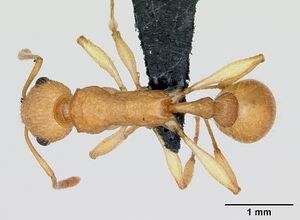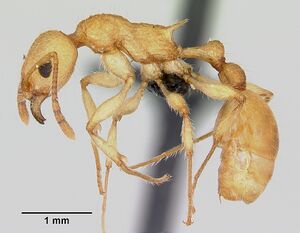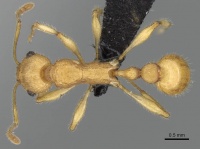Vitsika brevis
| Vitsika brevis | |
|---|---|

| |
| Scientific classification | |
| Kingdom: | Animalia |
| Phylum: | Arthropoda |
| Class: | Insecta |
| Order: | Hymenoptera |
| Family: | Formicidae |
| Subfamily: | Myrmicinae |
| Tribe: | Crematogastrini |
| Genus: | Vitsika |
| Species: | V. brevis |
| Binomial name | |
| Vitsika brevis (Bolton & Fisher, 2014) | |
V. brevis appears to nest in dead twigs on the surface of the ground in rainforest. It has also been retrieved from leaf litter samples and has been discovered foraging on low vegetation.
Identification
Very similar to, and mostly matching the description of, Vitsika producta, but with an obviously 3-segmented antennal club, in which funiculus segment 8 is only 1.00–1.25 times longer than broad, and funiculus segment 9 is relatively elongated, 1.70–2.00 × longer than funiculus segment 8. The antennal scape is relatively shorter in brevis, SI 99–111, than in producta, SI 115–129. In addition, the head capsule of producta averages relatively slightly narrower, CI 75–80, as opposed to CI 79–85 in brevis.
Distribution
Latitudinal Distribution Pattern
Latitudinal Range: -14.43361111° to -14.43361111°.
| North Temperate |
North Subtropical |
Tropical | South Subtropical |
South Temperate |
- Source: AntMaps
Distribution based on Regional Taxon Lists
Malagasy Region: Madagascar (type locality).
Distribution based on AntMaps
Distribution based on AntWeb specimens
Check data from AntWeb
Countries Occupied
| Number of countries occupied by this species based on AntWiki Regional Taxon Lists. In general, fewer countries occupied indicates a narrower range, while more countries indicates a more widespread species. |

|
Estimated Abundance
| Relative abundance based on number of AntMaps records per species (this species within the purple bar). Fewer records (to the left) indicates a less abundant/encountered species while more records (to the right) indicates more abundant/encountered species. |

|
Biology
Castes
Known only from the worker caste.
Images from AntWeb
   
| |
| Worker. Specimen code casent0494750. Photographer April Nobile, uploaded by California Academy of Sciences. | Owned by CAS, San Francisco, CA, USA. |
Nomenclature
The following information is derived from Barry Bolton's Online Catalogue of the Ants of the World.
- brevis. Myrmisaraka brevis Bolton & Fisher, 2014: 35, figs. 30-32, Map 132 (w.) MADAGASCAR.
- Combination in Vitsika: Fisher & Bolton, 2016: 448.
Unless otherwise noted the text for the remainder of this section is reported from the publication that includes the original description.
Description
Worker
(holotype in parentheses). TL 4.6–5.1 (5.0), HL 1.00–1.10 (1.02), HW 0.79–0.92 (0.83), CI 79–85 (81), SL 0.80–0.96 (0.88), SI 99–111 (106), PW 0.58–0.68 (0.62), WL 1.30–1.42 (1.34), MfL 1.02–1.18 (1.10) (20 measured).
Type Material
Holotype worker (top specimen of three on pin), Madagascar: Prov. Antsiranana, P.N. Marojejy, 27.6 km. 35° NE Andapa, 775 m., 14°26.1’S, 49°45.6’E, 15–18.xi.2003, ex dead twig above ground, rainforest, BLF 9049, CASENT0494587 (Fisher et al.) (California Academy of Sciences). Paratypes. 2 workers on same pin as holotype; 3 workers with same data as holotype but CASENT0494588; 3 workers with same data as holotype but CASENT0494589 (CASC).
References
- Bolton, B. & Fisher, B.L. 2014. The Madagascan endemic myrmicine ants related to Eutetramorium (Hymenoptera: Formicidae): taxonomy of the genera Eutetramorium Emery, Malagidris nom. n., Myrmisaraka gen. n., Royidris gen. n., and Vitsika gen. n. Zootaxa 3791:1–99. doi:10.11646/zootaxa.3791.1.1
- Fisher, B. L.; Bolton, B. 2016. Ants of Africa and Madagascar, a guide to the genus. University of California Press. 503pp.

